Similar presentations:
Water soluble vitamins
1. Water soluble vitamins
2. Vitamins
•Vitamins are vital low-molecular organiccompounds, which required in very small
quantities.
•Vitamins are chemically unrelated organic
compounds that cannot be synthesized in
adequate quantities by humans and,
therefore, must be supplied by the diet.
3.
•Ten vitamins (folic acid, cobalamin, ascorbicacid, bioflavonoids, pyridoxine, thiamine,
niacin, riboflavin, biotin, and pantothenic
acid) are classified as water soluble. Because
they are readily excreted in the urine, toxicity
is rare. However, deficiencies can occur
quickly.
4.
• Four vitamins (A, D, K, and E) are termed fatsoluble . They are released, absorbed, and
transported (in chylomicrons) with dietary fat.
They are not readily excreted, and significant
quantities are stored in the liver and adipose
tissue. In fact, consumption of vitamins A and D
in excess of the Dietary Reference Intakes can
lead to accumulation of toxic quantities of these
compounds.
5.
• Vitamins are required to perform specific cellularfunctions. For example, many of the water-soluble
vitamins are precursors of coenzymes for the
enzymes of intermediary metabolism.
In contrast to the water-soluble vitamins, only one
fatsoluble vitamin (vitamin K) has a coenzyme
function.
6. Water soluble vitamins
• B ComplexEnergy releasing: thiamine,
niacin, riboflavin, biotin,
pantothenic acid
hematopoietic:
folic acid, cobalamin
other: pyridoxine
Non-B Complex
ascorbic acid
bioflavonoids
7. B Complex vitamins
•Mainly contained in plant foods,especially in shells and embryos of
cereal grains. Therefore, they are many
in flour and bran, as well as in yeast.
•In much smaller quantities are found in
food of animal origin (liver, kidneys,
brain, egg yolk).
8. Exceptions
•Leafy, dark green vegetables are a goodsource of folic acid.
•Cobalamin is present in appreciable amounts
in liver, red meat, fish, eggs, dairy products,
and fortified cereals.
•A metabolite of tryptophan, quinolinate, can
be converted to NAD(P). In comparison, 60
mg of tryptophan = 1 mg of niacin.
9. The daily requirement of adult healthy person in vitamins В
• Vitamins В1, В2-1,5-2,0 mg• Pyridoxine – 2-4 mg
• Pantothenic acid -10 mg
• Niacin-15-25 mg
• В12- 0,025-0,05 mg
• Вс -0,18-0,4 mg
• Vitamins Н – 0,115-0,120 mg
10. The concept of hypovitaminosis and avitaminosis
• Avitaminosis – are disease that occurs at completeabsence in food or complete violation absorption of
a vitamin.
• Hypovitaminosis – are conditions due to
insufficient intake of vitamins with food or
incomplete its digestion.
• Hypovitaminosis and avitaminosis can be primary
and secondary.
11. The reasons of primary hypovitaminosis and avitaminosis
Insufficient intake or completeabsence of vitamins in food.
12. The reasons of secondary hypovitaminosis and avitaminosis
• Vitamins are present in food, but do not enter the innermedium of the organism.
• Reasons :
- Diseases of the gastrointestinal tract in which
absorption of vitamins is violated.
- The lack of fats in the diet, which are necessary for
absorption fat-soluble vitamins.
- Diseases of liver and biliary tract, which leads to
violation absorption of fat-soluble vitamins.
13. The reasons of secondary hypovitaminosis and avitaminosis
- Parasiticdiseases because parasites absorb vitamins
or destroy them.
- Violation of activation absorbed vitamins as a result
diseases internal organs (liver, kidneys).
- Treatment by antibiotics and sulfanilamide
preparations for a long time, these drugs suppress
the intestinal microflora and reduce the synthesis of
vitamins.
14. The reasons of secondary hypovitaminosis and avitaminosis
- Applicationof antivitamins.
- Relative insufficiency with increased need for
vitamins in pregnancy, breastfeeding, heavy physical
labor.
15. Antivitamins
• Antivitamins – are structural analogs of vitamins.• Bacteria for their growth and reproduction require
the presence of many vitamins for the synthesis of
coenzymes.
• Injection in the body of antivitamins leads to the
death of microorganisms. Antivitamins usually block
the active sites of enzymes and cause competitive
inhibition of enzymes.
16. Vitamers
• Vitamers are structural analogs of vitamins, which have vitaminactivity.
• For instance, vitamers of vitamin В6 - pyridoxol, pyridoxal,
pyridoxamine.
17.
Thiamin (Vitamin B1)
Riboflavin (Vitamin B2)
Niacin (B3)
Pyridoxine Vitamin B6)
Biotin
Folic acid
Cyanocobalamin
(Vitamin B12)
• Pantothenic acid
• These vitamins are chemically not related to one another.
• They are grouped together because all of them function in the cells as
precursors of coenzymes.
18.
19. Biochemical Role of Coenzymes and Vitamins
CoenzymeRelated vitamin
Chemical reaction
NAD+, NADP+
Niacin
Oxidation-reduction
FAD
Riboflavin (B2)
Oxidation-reduction
Thiamine
pyrophosphate
Thiamine (B1)
Aldehyde group
transfer
Coenzyme A
Pantothenate
Acyl group transfer
Tetrahydrofolate
Folate
Transfer of onecarbon groups
Biotin
Biotin
Carboxylation
Pyridoxal phosphate Pyridoxal (B6)
Dr. Siham Gritly
Transamination
19
20.
21. THIAMINE (VITAMIN B1)
• Thiamine is also called as vitamin B1 In old literature, it isdesignated as Aneurine (it can relieve neuritis) or anti Beri
Beri factor.
• Its active co-enzyme(major function) form is thiamine
pyrophosphate (TPP)
• It is formed by addition of two phosphate groups, with the
help of ATP
22. Thiamine : B1
23. Functions of B1:
1. Enzyme cofactor: (Thiamine pyrophosphateTPP or TDP)
A. Decarboxylation reactions
Pyruvate dehydrogenase
α-ketoglutarate dehydrogenase
α-keto acid dehydrogenase – branched
chain amino acid metabolism.
B. Transketolation reactions
Transketolase – Pentose Phosphate
pathway
24. Decarboxylation reactions
A.Decarboxylation reactions
• Pyruvate dehydrogenase complexed to TPP: it catalyzes
the breakdown of pyruvate, to acetyl CoA, and carbon
dioxide
25. Decarboxylation reactions
A. Decarboxylation reactions• II.Alpha ketoglutarate dehydrogenase: requires TPP is
the decarboxylation of alpha ketoglutarate to succinyl CoA
and CO2
26.
27. Transketolation reactions
A. Transketolation reactions• III. Transketolase: The second group of enzymes that use
TPP as co-enzyme are the transketolases, in the Pentose
phosphate pathway( PPP ) of glucose
28. Thiamin status is affected by:
1.Food processing – washing, polishing etc.
2.Ethanol ingestion / alcoholism
Reduces thiamin intake
Impaired intestinal absorption
Alters phosphorylation of thiamine
Increases excretion
29. Thiamine deficiency
•In thiamine deficiency, the activity ofthese two dehydrogenase-catalyzed
reactions is decreased, resulting in
decreased production of ATP and,
therefore, impaired cellular function.
30. Vitamin B1
Thiamine deficiency is diagnosed by an increase inerythrocyte transketolase activity observed on
addition of TPP.
Beriberi: This is a severe thiamine-deficiency
syndrome found in areas where polished rice is the
major component of the diet.
Adult beriberi is classified as dry (characterized by
peripheral neurologic deficits) or wet (characterized
by edema due to cardiac
dysfunction).
31. Wernicke-Korsakoff syndrome
In the United States, thiamine deficiency, which is seenprimarily in association with chronic alcoholism, is due
to dietary insufficiency or impaired intestinal absorption
of the vitamin.
• Some alcoholics develop Wernicke-Korsakoff syndrome,
a thiamine deficiency state characterized by confusion,
ataxia, and a rhythmic to-and-fro motion of the eyeballs
(nystagmus) with Wernicke encephalopathy as well as
memory problems and hallucinations with Korsakoff
dementia.
• The syndrome is treatable with thiamine
supplementation, but recovery of memory is typically
incomplete.
32. Deficiency Diseases of B1:
• BeriberiWet beriberi
Dry beriberi
Infantile beriberi
• Wernicke-Korsakoff syndrome: inability to
coordinate voluntary muscle movements;
unsteady movements and staggering gait
• Polyneuritis: inflammation of a nerve
accompanied by pain and sometimes loss of
function
33. Wet Beri Beri:
Cardiovascular manifestationsedema
palpitations
breathlessness
fatigue
distended neck veins
cause of death: cardiac failure
34. Deficiency Manifestations of Thiamine
• B. Wet beriberi:. cardiac beriberi• Edema of legs
• face, trunk and
serous cavities
• Palpitation,
breathlessness
distended neck
veins
• Death occurs due
to heart failure.
35. Biochemical basis of wet beriberi:
PyruvateLactate
(-)
Acetyl CoA
Acidosis
Depression of vasomotor center
Decreased Vascular resistance
Peripheral vasodilatation
36. Dry Beriberi (paralytic / nervous)
CNS manifestations:muscle weakness
gait disturbance
paralysis
calf muscle tenderness
impairment of sensory, motor and reflex
functions
( distal segment of limbs > proximal
segment)
37. Deficiency Manifestations of Thiamine
• Dry Beriberi (peripheral neuritis ): Walking becomes difficult.Peripheral neuritis with sensory disturbance leads to complete
paralysis
38. Infantile beri-beri:
• Maternal malnutrition• Age group: 2 – 3 months
• 3 forms
Cardiac (acute fulminating)
Aphonic
Pseudomeningitic
39. Cerebral Beri beri:
High risk groups:Alcoholism
Chronic dialysis
Clinical features:
Wernicke’s encephalopathy – ataxia, confusion
and opthalmoplegia.
Korsakoff psychosis – amnesia and
confabulation – impairment of conceptual
function decreased spontaneity and initiative
40.
41. Riboflavin : B2
• Heat stable, light sensitive , luminescent vitamin – UV light• Vitamin B2 , lactoflavin, Warburg’s yellow enzyme
• Source – whole cereals, legumes (beans), eggs , milk
• Daily Requirement
• Riboflavin is concerned mainly with the metabolism of
carbohydrates and requirement is related to calorie
intake.
• Adults on sedentary work require about 1.5 mg per day.
During pregnancy, lactation and old age, additional 0.2 to
0.4 mg/day are required.
42. Co-enzyme forms:
• FMN – Flavin Mono Nucleotide• FAD – Flavin Adenine Dinucletide
• Riboflavin
FMN
Flavokinase
FAD
synthase
FAD
43. Functions:
• Integral component of electron transport chainATP Synthesis ----NAD FMN CoQ
• Component of several enzymes in the metabolic
pathway
• TCA cycle succinate dehydrogenase
• Fatty Acid Oxidation acyl CoA dehydrogenase
• Amino acid oxidation As a part of alpha ketoglutarate
• Isocitrate dehydrogenase complex ( dihydrolipoate
dehydrogenase)
44. FMN-dependent Enzymes
• i. During the amino acid oxidation, FMN is reduced. It isreoxidized by molecular oxygen to produce hydrogen
peroxide
45. FAD-dependent enzymes
• 1. Succinate to fumarate by succinate dehydrogenase in TCA46. FAD-dependent enzymes
• Pyruvate dehydrogenase (Pyruvate to acetyl CoA)47. a-Ketoglutarate dehydrogenase (Alpha ketoglutarate to succinyl) CoA by alpha in TCA cycle
48. Riboflavin deficiency:
49. Deficiency manifestations:
• Glossitis - inflammation of tongueMagenta red colour(glossitis ), Fissures,
Atrophy of lingual papillae
• Cheilosis: fissures in lips
• Angular stomatits: inflammation at corners
of mouth
• Conjunctivitis
50. Riboflavin Deficiency
Riboflavin Deficiency(Cheilosis)
Riboflavin Deficiency
(Glossitis
50
51.
52. Niacin
•Niacin is found in unrefined andenriched grains and cereal; milk; and
lean meats, especially liver.
•Corn is low in both niacin and
tryptophan.
Corn-based diets can cause pellagra.
53. Niacin: B3
• Exists in two forms• Nicotinic acid (Niacin)
• Nicotinamide (Niacinamide)
• Two coenzyme forms of niacin
• NAD+
• NADP+
54. Function:
• Coenzymes are active participants in oxidationreduction reactions – Dehydrogenases• Function in at least 200 reaction in cellular
metabolic pathways
• NAD+
• Participates in catabolic reactions
• Electron and hydrogen ion acceptor
• NADP+
• Anabolic reactions
• Important in biochemical pathway for fatty-acid synthesis,
steroid and bile acid synthesis.
55. NAD+ dependent enzymes
• Lactate dehydrogenase (lactate → pyruvate)56. NADPH utilizing reactions
• 3. HMG CoA reductase (HMG CoA → mevalonate) in Fattyacid metabolism
57. Tryptophan can be converted to Niacin:
Tryptophan3-OH-kynurenine
FAD
B6
3-OH-anthranallic acid
Niacin
58. Deficiency manifestation:
• Pellagra , a disease involving the skin, gastrointestinaltract, and CNS:
• Dementia, Diarrhea, Dermatitis
• If not treated can cause death
• Develops about 50 to 60 days after a niacin
deficient diet
• Early symptoms
• Loss of appetite, weight loss, and weakness
• Mild symptoms
• Indigestion, canker sores, vomiting, depression
and fatigue
59. Pellagra niacin deficiency
5960. Pellagra Niacin deficiency
6061. Pellagra like symptoms can be seen with:
• Niacin deficiency• Hartnup disease Less absorption of Trp
• Carcinoid syndrome excess Trptophan going for Serotonin
synthesis and less for Niacin synthesis
• Pyridoxine deficiency Kynureninase is not working
• Isoniazid administration ANTI-TUBERCULOUS DRUG
damages liver and increased AST/ALT activity + directly
inhibits PLP formation
62. Niacin
Treatment of hyperlipidemia: Niacin at doses of 1.5 g/day,strongly inhibits lipolysis in adipose tissue, the primary
producer of circulating free fatty acids (FFAs). The liver
normally uses these circulating FFAs as a major precursor for
triacylglycerol (TAG) synthesis. Thus, niacin causes a
decrease in liver TAG synthesis, which is required for verylow-density lipoprotein [VLDL] production. Low-density
lipoprotein (LDL, the cholesterol-rich lipoprotein) is derived
from VLDL in the plasma.
Thus, both plasma TAG (in VLDL) and cholesterol (in LDL) are
lowered.
63. Niacin
Therefore, niacin is particularly useful in thetreatment of type llb hyperlipoproteinemia, in
which both VLDL and LDL are elevated. The high
doses of niacin required can cause acute,
prostaglandin- mediated flushing. Aspirin can
reduce this side effect by inhibiting prostaglandin
synthesis. [Note: Niacin raises
high-density lipoprotein levels.]
64.
65. Pantothenic acid: B5
• Contains Pantoic acid (derived from valine) and β-alanine(derived from aspartate)
• Carrier of acyl groups
• Involved in the metabolism of fat, proteins and
carbohydrates
• Active form – Coenzyme A (Co-A)
Acyl carrier protein.
66. Pantothenic acid: B5
• Sources of Pantothenic Acid• It is widely distributed in plants and animals. Moreover, it
is synthesized by the normal bacterial flora in intestines.
Therefore, deficiency is very rare. Yeast, liver and eggs are
good sources.
67. Pantothenic acid: B5 and Co-enzyme A
68. Functions of Co-A:
1. Cellular metabolism – Co-A derivativesii. The thio ester bond in acyl-CoA is a high energy bond.
These acyl groups are transferred to other acceptors,
• Acetyl CoA + Choline → Acetylcholine + CoA
• iii. Acyl groups are also accepted by CoA molecule during
the metabolism of other substrates, for example:’
• Pyruvate+CoA+NAD+ → AcetylCoA+CO2+NADH
69. Functions of Co-A:
1. Cellular metabolism – Co-A derivativesiv. The important CoA derivatives are:
a. Acetyl CoA
b. Succinyl CoA
c. Hydroxyl beta methyl glutaryl CoA (HMG CoA)
d. Acyl CoA.
70.
Sources and Uses of Co-A in Cellular metabolism71. Deficiency manifestations;
• Fatigue, irritabilitylow CoA levels
energy production
• Neurological symptoms
Numbness, muscle cramps
acetyl choline formation
• Burning foot syndrome :paresthesia (burning, lightning pain) in
lower extremities, staggering gait due to impaired coordination
and sleep disturbances.
• Hypoglycemia : decreased acylation of receptors – increased
binding of insulin.
72.
73. Pyridoxine: B6
• Three forms :1. Pyridoxine
2. Pyridoxal
3. Pyridoxamine – antioxidant
Active form of B6 – Pyridoxal phosphate (PLP)
74. Functions of B6: central role in metabolism
• Aminoacid metabolism:1. Transamination
2. Deamination
3. Decarboxylation
4. Transulfuration
1.
2.
Lipid metabolism :
Sphingomyelin synthesis
Carnitine synthesis
1.
2.
Carbohydrate metabolism :
Glycogenolysis – glycogen phosphorylase
Gluconeogenesis –formation of alpha keto acids
75. Other minor functions of B6
• Heme synthesis• Catecholamine synthesis
• Niacin synthesis
• Modulation of hormone action – mainly steroids
76. Transamination reactions : PLP prosthethic group of animo transferases
77. Decarboxylation reactions:
• Glutamate decarboxylase :Glutamate GABA (inhibitory
neurotransmittor)
Histidine decarboxylase :
Histidine Histamine
78. Transsulfuration :
• Cystathionine β synthase:Homocysteine + serine
• Cystathionase:
Cystathionine
B6 deficiency
PLP
PLP
Cystathionine
Homoserine + Cysteine
Homocysteine
Cardiovascular disease
79. Modulation of hormone action
B6 - Remove hormone-receptor complex fromDNA binding
Terminate the action of steroid hormone
B6 deficiency:
• Enhances steroid hormone sensitivity
• Increases risk for hormone dependent cancers
of breast and uterus
80. Drugs inactivating PLP:
• Alcohol• Isoniazid - Anti tubercular
• Carbidopa – used with DOPA in parkinsonism
• Penicillamine – chelating agent
• Oral contraceptive pills
81. Clinical indications for pyridoxine
•Isoniazid, a drug commonly used to treattuberculosis, can induce a vitamin B6
deficiency by forming an inactive derivative
with PLP.
•Dietary supplementation with B6 is, thus, an
adjunct to isoniazid treatment. Otherwise,
dietary deficiencies in pyridoxine are rare but
have been observed in newborn infants fed
formulas low in B6, in women taking oral
contraceptives, and in alcoholics.
82. Deficiency manifestation:
• Neurological manifestations:Peripheral neuritis
convulsions
Basis: Formation of catecholamine
GABA levels
Sphingolipid synthesis
Demyelination
• Dermatitis - (pellagra like symptoms)
• Microcytic hypochromic Anemia – decreased
formation of Heme
83. Diagnosis of B6 deficiency:
• Decreased AST and ALT activity• Methionine load test – Homocysteine and cystathionine in
urine.
• Tryptophan load test – Xanthurenic acid
84. Toxicity of Vitamin B6
• Toxicity of Vitamin B6. Pyridoxine is the only water-solublevitamin with significant toxicity.
Doses over 100 mg may lead to sensory neuropathy.
Further excess is manifested by imbalance, numbness,
muscle weakness and nerve damage.
Substantial improvement, but not complete recovery, occurs
when the vitamin is discontinued.
85.
86. Biotin: B7
• Co-enzyme for carboxylation reaction:• Carboxylation require Bicarbonate, ATP and Biotin.
Mitochondrial
87. Biotin acts as co-enzyme for carboxylation reactions.
• Biotin captures a molecule of CO2 which is attached tonitrogen of the biotin molecule. The energy required for
this reaction is provided by ATP.
88. Biotin Requiring CO2 Fixation Reactions
• Acetyl CoA carboxylase• This enzyme adds CO2 to acetyl CoA to form malonyl CoA.
This is the rate limiting reaction in biosynthesis of fatty
acids
• Acetyl CoA +CO2+ATP→ Malonyl CoA + ADP+Pi
89. Biotin Requiring CO2 Fixation Reactions
• Propionyl CoA Carboxylase• Propionyl CoA +CO2+ATP→ Methyl malonyl CoA +ADP+Pi
90. Biotin Requiring CO2 Fixation Reactions
Pyruvate Carboxylase• Pyruvate + CO2 +ATP→ Oxaloacetate +ADP +Pi This is
important in two aspects.
• One, it provides the oxaloacetate, which is the catalyst for
TCA cycle.
• Second, it is an important enzyme in the gluconeogenic
pathway
91. Biotin deficiency: causes
• Consumption of raw egg – Avidin ( binds biotin)• Dialysis
• Requirement of Biotin
• About 200–300 mg will meet the daily requirements
92. Features of biotin deficiency
• Vitamin H – (Haar and Haut) Hair and skin in German• Biotin deficient faces – unusual fat distribution with a
characteristic rash.
Symptoms :
1. Periorificial dermatitis
2. Conjunctivitis
3. Alopecial (loss of hair (especially on the head)
4. Neurological – Tingling and numbness , depression ,
lethargy.
93. Biochemical basis:
• CNS features : Defect in Pyruvate carboxylase lacticacidemia.
• Skin rash and hair loss – due to abnormal fatty acid
metabolism mainly of omega -6 – fatty acids.
• Biotinylation of histones – regulation of transcription and
cell proliferation – is affected.
94. Biotin
• Biotin deficiency does not occur naturally because the vitamin iswidely distributed in food. Also, a large percentage of the biotin
requirement in humans is supplied by intestinal bacteria.
However, the addition of raw egg white to the diet as a source of
protein induces symptoms of biotin deficiency, namely, dermatitis,
glossitis, loss of appetite, and nausea.
• Raw egg white contains a glycoprotein, avidin, which tightly binds
biotin and prevents its absorption from the intestine.
• With a normal diet, however, it has been estimated that 20
eggs/day would be required to induce a deficiency syndrome.
Thus, inclusion of an occasional raw egg in the diet does not lead
to biotin deficiency, although eating raw eggs is generally not
recommended due to the possibility of salmonella infection.
95.
96. Folic Acid
97.
98. Folate metabolism:
• Folic acid is present as various forms of Tetrahydrofolate :• Acts as a co-enzyme by accepting, transfering, or modyfying
one carbon units that are attached to N5 or N10 position of
folate.
Fig. N5, N10-methenyl THFA. One carbon unit (red ring ) is attached
to N5 and N10 groups (blue rings) of tetrahydrofolic acid
99. Active one carbon donors
•:1.
2.
3.
4.
Formyl THF – purine synthesis
Methylene THF – pyrimidine synthesis
Methenyl THF
Intermediates
Formimino THF
Predominant form in plasma – methyl THF (reduced) and
inactive.
100. Folic acid (Bc)
• Function of folic acid:Tetrahydrofolate (THF), the reduced, coenzyme form of
folate, receives one-carbon fragments from donors such as
serine, glycine, and histidine and transfers them to
intermediates in the synthesis of amino acids, purines, and
thymidine monophosphate (TMP), a pyrimidine nucleotide
found in DNA.
101. Functions of Folate: 1. DNA synthesis 2. Conversion of Homocysteine to methionine
Purinesynthesis
Folate
Dihydrofolate
THF
Methionine
Formyl THF
Methenyl THF
Methylene THF
Pyrimidine
synthesis
B 12
Homocysteine
Methyl THF
(reduced)
102. Pyrimidine synthesis:
Methylene THFd-UMP
Purine synthesis:
DHF
Thymidylate
synthase
d-TMP
Carbon 2 and 8 of the purine ring is donated
by formyl THF
103. Deficiency of Folate :
Causes :Malabsorption syndromes-poor absorption caused by
pathology of the small intestine, alcoholism
Drugs –
Valproic acid – Neural tube defects
Sulfasalazine
Methotrexate – that are dihydrofolate reductase inhibitors.
Increased demands – Pregnancy
Lactation
104. Deficiency manifestation:
• Reduced DNA synthesis• Macrocytic Anemia -
results from a deficiency in folic
acid, or vitamin B12. These macrocytic anemias are commonly called
megaloblastic because a deficiency of either vitamin (or both) causes
accumulation of large, immature RBC precursors, known as
megaloblasts, in the bone marrow and the blood.
• Homocysteinuria
• Neural tube defects in fetus.
105. Deficiency manifestation
• A folate-free diet can cause a deficiency within a few weeks.• Reduced DNA synthesis
• In folate deficiency, THFA is reduced and thymidylate
synthase enzyme is inhibited.
• Hence dUMP is not converted to dTMP. So dTTP is not
available for DNA synthesis.
• Thus cell division is arrested. Very rapidly dividing cells in
bone marrow and intestinal mucosa are therefore most
seriously affected.
106. Deficiency manifestation
• Macrocytic Anemia• It is when RBC’s are larger than their
normal volume.
• Cells are larger because they cannot
produce DNA quickly enough to divide at
the right time as they grow, and thus
grow too large before division
• there is insufficient numbers of cells
and hemoglobin content per cell
107. Deficiency manifestation
• Hyperhomocysteinemia• Folic acid deficiency may cause increased homocysteine
levels in blood since remethylation of homocysteine Is
affected.
108.
109. Vitamin B12
• Only animal source – vegetarians ??• Only water soluble vitamin that can be stored up to some
extent
• Contains cobalt.
• Synthetic preparation : injectables
1. Hydroxycobalamin
2. Cyanocobalamin – easily crystalized and extracted from
bacteria.
110. Vitamin B12
1.Methyl cobalamin – predominant function in plasma
Converts homocysteine to methionine with transfer of
methyl group from Methyl THF.
Enzyme – homocysteine methyl transferase/methionine
synthase
2. Deoxyadenosylcobalamin – mitochondrial
Converts methylmalonyl Co-A to succinyl co-A
Enzyme – methyl malonyl Co-A mutase
111. Conversion of methyl malonyl Co-A to succinyl Co-A
Methylmalonyl Co-A
mutase
(B12)
112. Deficiency manifestation:
• Megaloblastic anemia• Methylmalonic aciduria
• Neurological manifestation:
a) Myelopathy – myelin loss, axonal degeneration and Gliosis
b) Larger fibres are affected – posterior and lateral columns –
Subacute combined degeneration of spinal chord.
c) Loss of vibratory and position sense, ataxia. Intact motor
fibres
113. Biochemical basis:
• Hematological - Folate trap – decreased methylation of DNA• Neurological –
1. Abnormal propionate metabolism
2. Accumulation of methyl malonyl Co-A –toxin
3. Abnormal fatty acid synthesis and myelination
114. Megaloblastic anemia:
Vitamin B12 def• Neurological manifestations
present
• Methylmalonic aciduria
• Pernicious anemia
• Develops in years
• Vegan diet
• Absent
Folate Def
• Absent neurological
manifestations
• Absent
• Not related
• Develops in months
• Alcoholism
• Neural tube defects in
foetus
115. Homocysteine metabolism:
One carbon donorsS- Adenosyl Methionine
(SAM)
Methionine
THF
Homocysteine
methyl transferase
Methyl THF
S- Adenosyl Homocysteine
B12
Homocysteine
PLP
Cystathionine β
synthase
Cystathionine
PLP
Cystathionin
ase
Cysteine
116. VITAMIN C (ASCORBIC ACID)
• Chemistry• It is a sugar acid known as hexuronic acid. Ascorbic acid is
easily oxidized by atomospheric O2 to dehydroascarobic
acid .
• High temperature (cooking) accelerates oxidation. Light and
alkali also promotes oxidation
117. Functions
• 1. Ascorbic acid act as antioxidant. It is free radicalscavenger. Since it is a strong reducing agent it protects
carotenes, vitamin E and other B vitamins of dietary origin
from oxidation.
• 2. It is required for the hydroxylation of proline and lysine
residues of collagen. Since collagen is component of ground
substance of capillaries, bone and teeth vitamin C is
required for proper bone and teeth formation also.
• 3. It participates in hydroxylation reactions of steroid
biosynthesis.
• 4. It is required for catecholamine synthesis from tyrosine.
• 5. In the liver bile acid synthesis requires ascorbic acid.
118.
• acidHydroxylation of proline to hydroxyproline needs ascorbic
119. Functions
• 6. Ascorbic acid participates in the synthesis of carnitine.• 7. It is required for the absorption of iron in the intestine.
It maintains iron in ferrous form.
• 8. Catabolism of tyrosine requires ascorbic acid.
• 9. When given in large doses it reduces severity of cold.
However evidence is lacking.
• 10. Vitamin C is effective in controlling bacterial invasion by
inhibiting activity of bacterial hyaluronidase enzyme. It acts
as inhibitor of this enzyme due to structural similarity to
glucuronate of hyaluronin, the substrate of hyaluronidase.
120.
121. Vitamin C deficiency
• 1. In adults deficiency of vitamin C causes scurvy.But it rarely occurs in normal people.
• The symptoms of scurvy are
(a) Haemorrhages in various tissues particularly in inside of thigh,
calf and forearm muscles. It may be due to capillary fragility.
(b) General weakness and anaemia.
(c) Swollen joints, swollen gums and loose tooth.
(d) Susceptible for infections.
(e) Delayed wound healing.
(f) Bone fragility and osteoporosis.
• 2. Vitamin C deficiency in infants gives rise to infantile
scurvy. It occurs in weaned infants who are fed on diets low
in vitamin C.
122.
•v(A) Gingivitis and bleeding gum in vitamin C deficiency;
(B) Lime and (C) Gooseberry are good sources of vitamin C
123.
• Sources• Amla (indian gooseberry), guava, coriander and amarnath
leaves, and cabbage are rich sources.
• Fruits like lemon, orange, pineapple, papaya, mango and
tomato are good sources. Apples, bananas and grapes are
fair sources.
• Daily requirement (RDA)
• Adults : 60-80 mg/day.
124. Therapeutic uses
• Large doses of Vit C are used to treat common cold, softtissue infections.
• Since it is an antioxidant it reduces incidence of cancer,
cardiovascular diseases and act as anti aging agent also.
125. Bioflavonoids (“vitamin of Permeability”)
• Bioflavonoids are a group of naturally occurring plant compounds,which act primarily as plant pigments and antioxidants. They
exhibit a host of biological activities, most notably for their
powerful antioxidant properties.
• Bioflavonoids work with other antioxidants to offer a system of
protection. Numerous studies have shown their unique role in
protecting vitamin C from oxidation in the body, thereby allowing the
body to reap more benefits from vitamin C.
• Bioflavonoids inhibit hyaluronidase, resulting in increase of vessels
strength (decrease of permeability)
126. Bioflavonoids (vitamin P) continue
• Bioflavonoids Health BenefitsThe main health benefits of bioflavonoids fall into two categories:
health-promoting effects and therapeutic effects. The healthpromoting effects include better eyesight, improved cardiovascular
health, increased capillary strength, improved structure of connective
tissues and appearance of skin, and a stronger immune system.
• Bioflavonoids also offer the health-promoting effect of lowering the
risk of some diseases, such as atherosclerosis, cancer, arthritis, and
gastrointestinal disorders. The therapeutic applications include
treating a variety of diseases and disorders. Several of these are
coronary heart disease, allergies, inflammation, hemorrhoids,
respiratory diseases, viral infections, some types of cancer, and
peptic ulcers.
127. Bioflavonoid Superstars
• Different bioflavonoids tend to have different health effects on thebody. Some of the common bioflavonoids and their benefits are
outlined below.
• Quercetin’s primary use is for the relief of allergies and inflammation.
In scientific experiments, it was found to be an effective inhibitor of
histamine release from mast cells – the cause of allergic reactions.
• Pycnogenol™ has cardiovascular benefits, boosts the immune system,
helps improve the appearance of the skin, helps varicose veins,
provides relief from arthritic pain, and helps reduce inflammation.
• Rutin (and drug as ascorutin) for blood vessels and immune system
128. Bioflavonoid Superstars (continue)
• Grape seed extract has beneficial effects on the circulatory system.Some of these include improvements to cardiovascular health,
protective antioxidant effects, improved eye health, and antiinflammatory action.
• Green tea extract plays a beneficial role in protecting against certain
infections, improving cardiovascular health, promoting better dental
hygiene, and offering protection from the development of some
types of cancer.
• Daily needs 25-50 mg/day
129. Avitaminosis and sources of vit.P
• Bioflavonoids are present in all botanical supplement products andfoods. In fact, many medicinal herbs owe their curative actions to the
bioflavonoids they contain. Besides the important antioxidant effects,
bioflavonoids help the body maintain health and function in many
ways. They have been shown to be anti-mutagenic, anti-carcinogenic,
anti-aging, and promote structure and function in the circulatory
system.
• Avitaminosis is exhibited by petehii (subcutaneous bleeding points
due to increased permeability), however there is no separate
avitaminosis P. More often is avitaminosis of vitamin C and P (scurvy)
130.
131.
132.
A- ATPB- BIOTIN
C- CO2
REM - VOMIT
MAIN
ATP
SYNTHESIS
DECREASEDATP
Na+K+ PUMP
FAILURE CELLS
SWELL AND DIE
KAPLAN Step 1 notes
133.
V.Imp SOURCEOF e0 -1 for ETC
Left untreated
death !!
U T
DNA and RNA
synthesis
KAPLAN Step 1 notes
134.
KAPLAN Step 1 notesSUBACUTRE COMBINED
DEGENERATION
1)Regeneration of
TETRAHYDROFOLATE (ACTIVE
FOLATE ) DNA and RNA
synthesis
ANYTHING THAT DAMAGES LIVER
OR ANYTHING THAT INCTREASED AST/ALT
ACTIVITY INCREASED NEED FOR PLP
LESS HEME SMALL RBCs IRON NOT
USED IRON DEPOSITED IN
PRECURSORS OF RBCS SIDEROBLASTS
135.
ATPSTOMACH ACIDITY
AND VIT C
Fe+3 Fe +2
CoA
KAPLAN Step 1 notes






















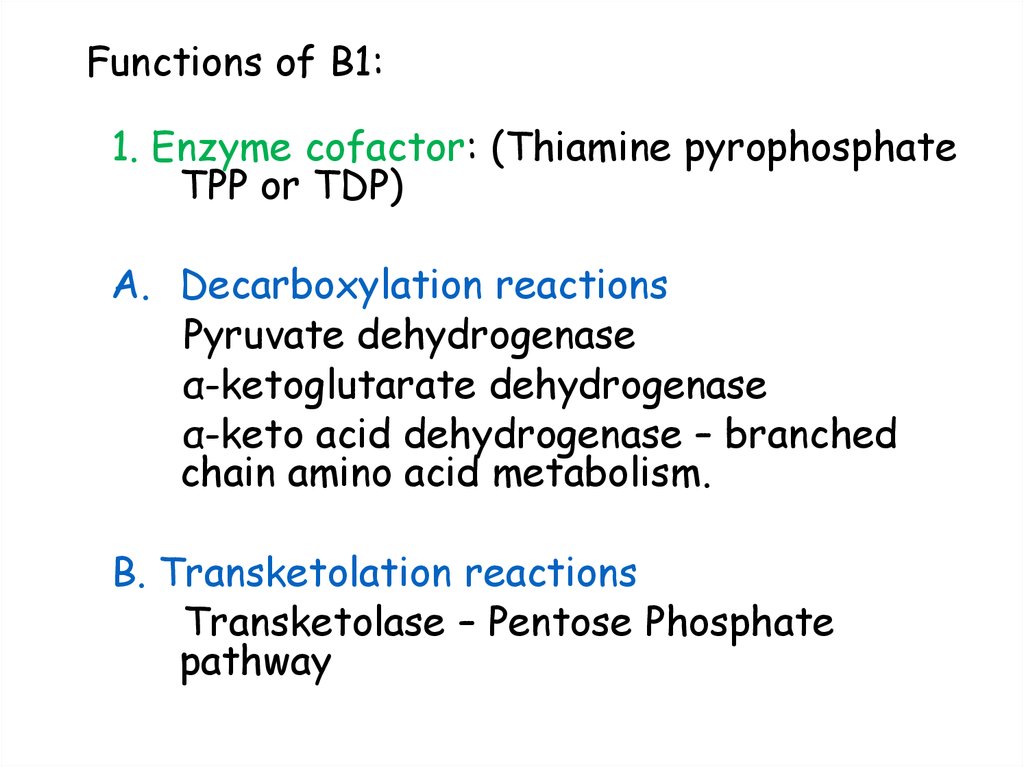







































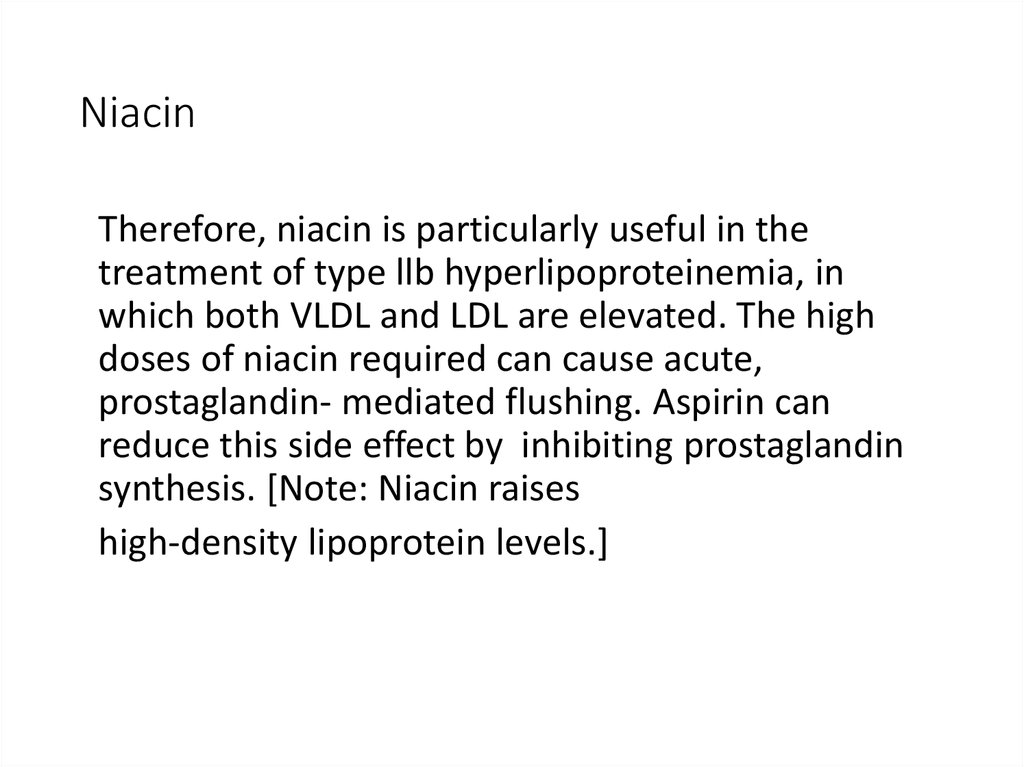



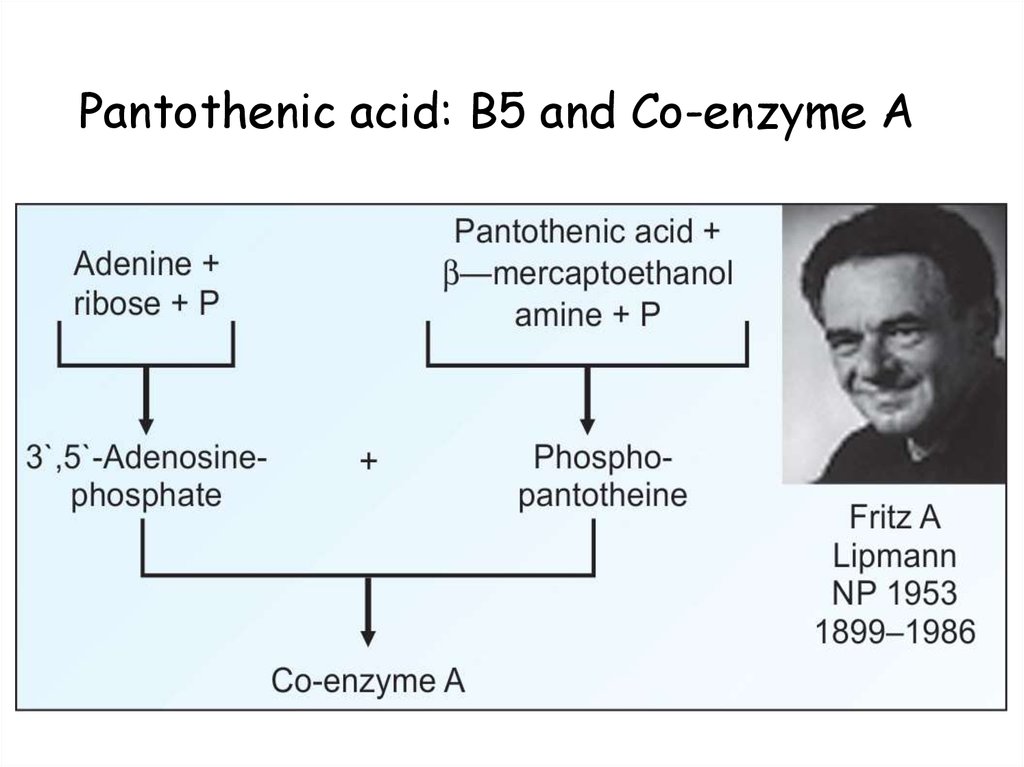


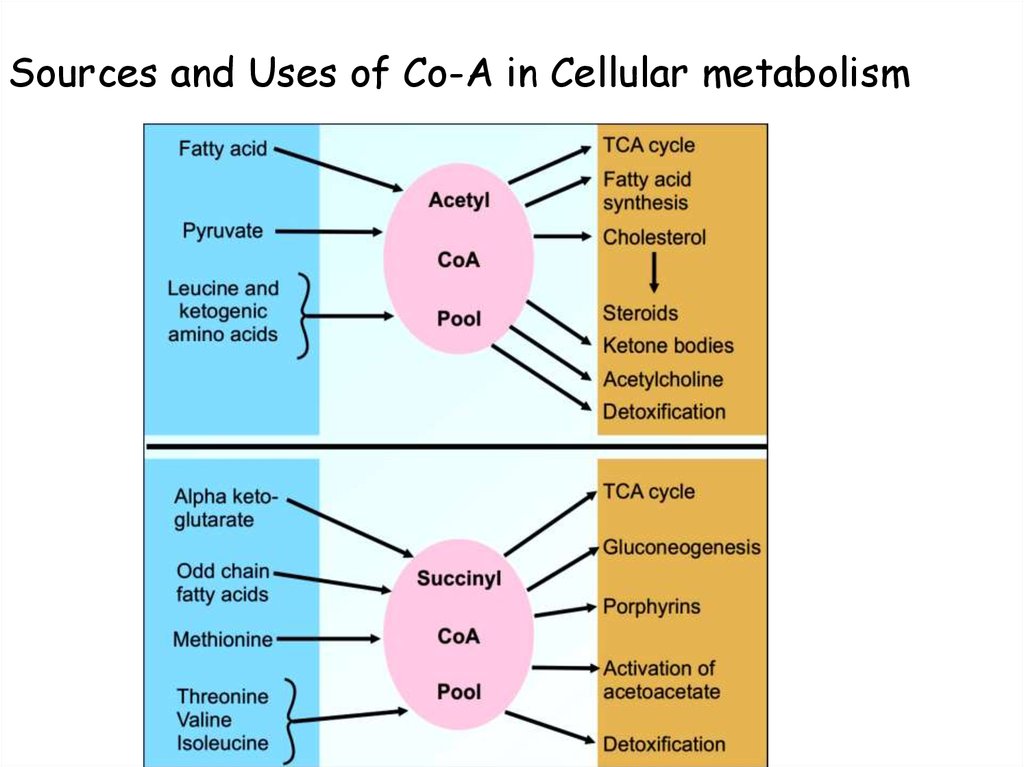


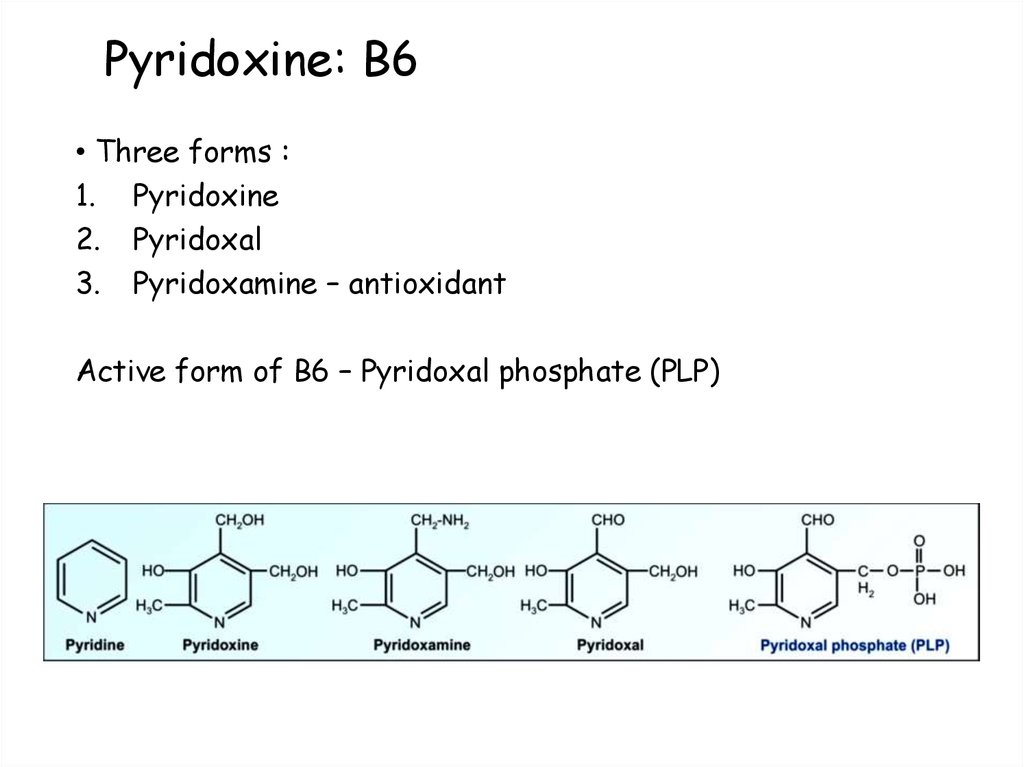






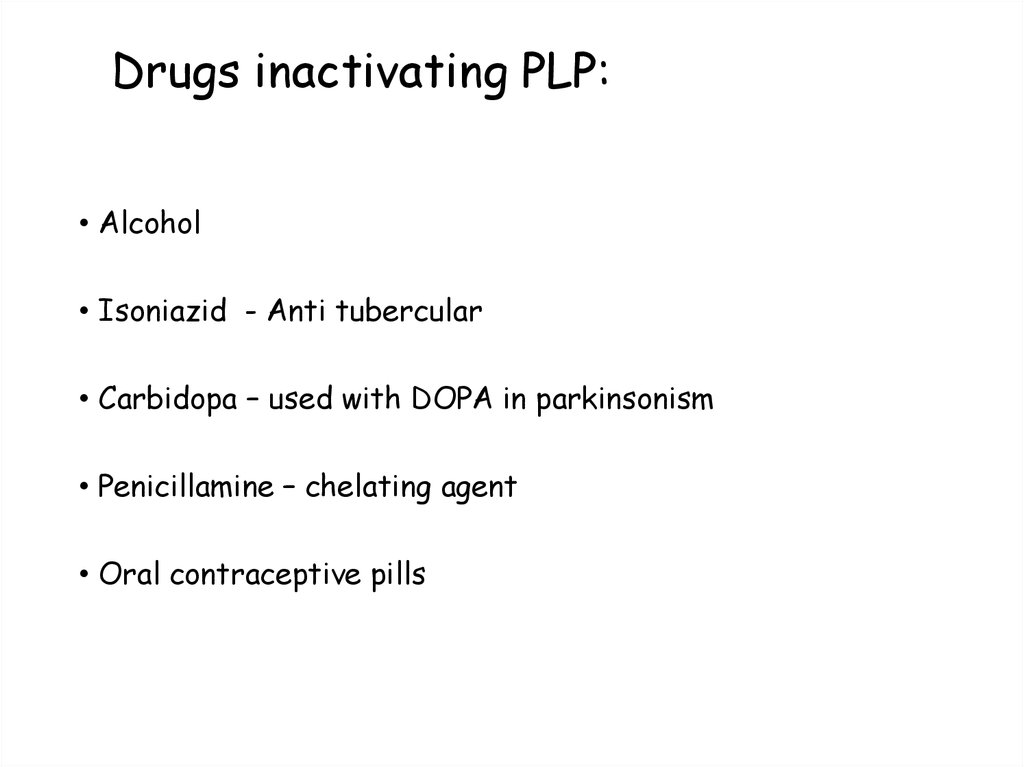













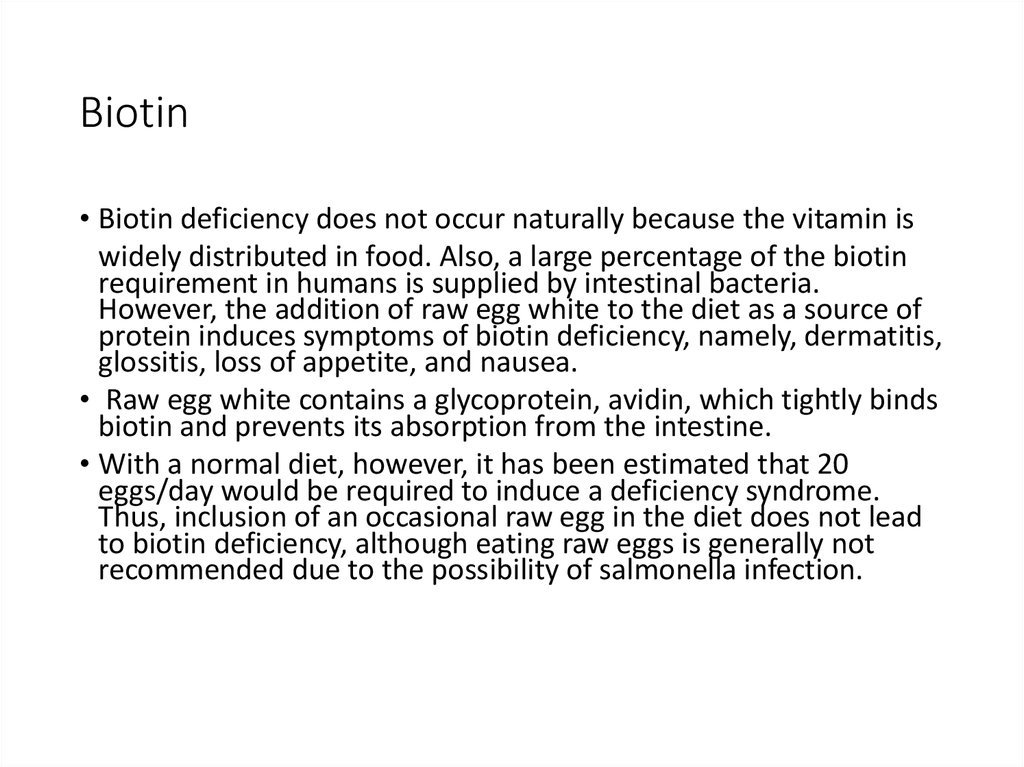

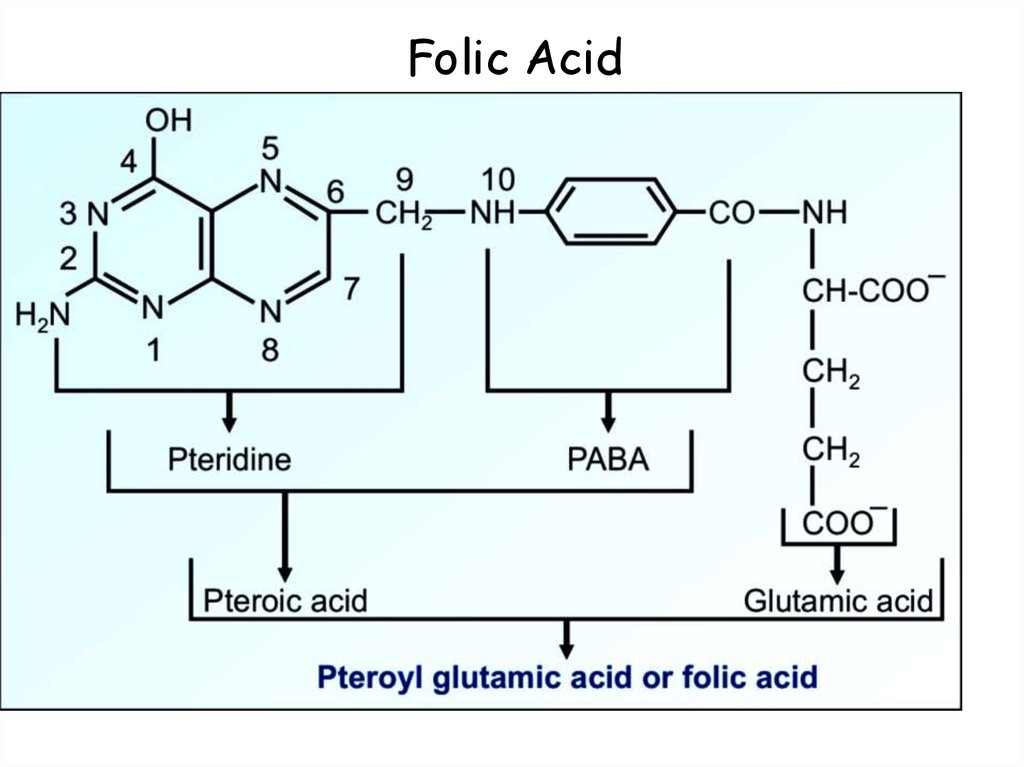
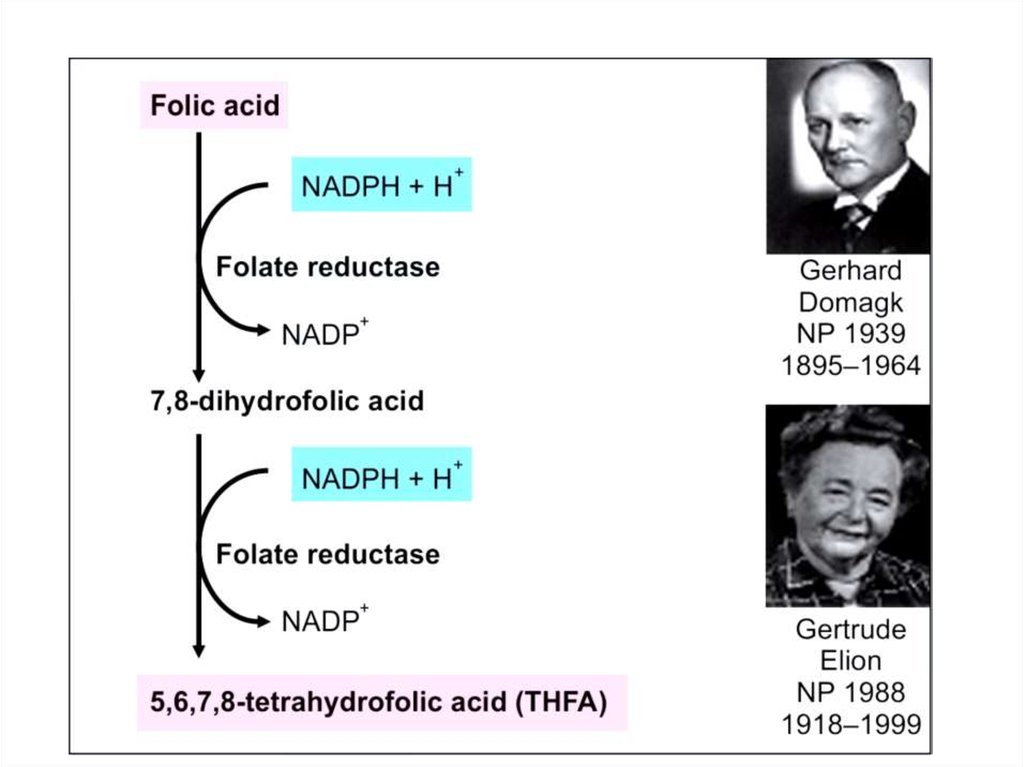














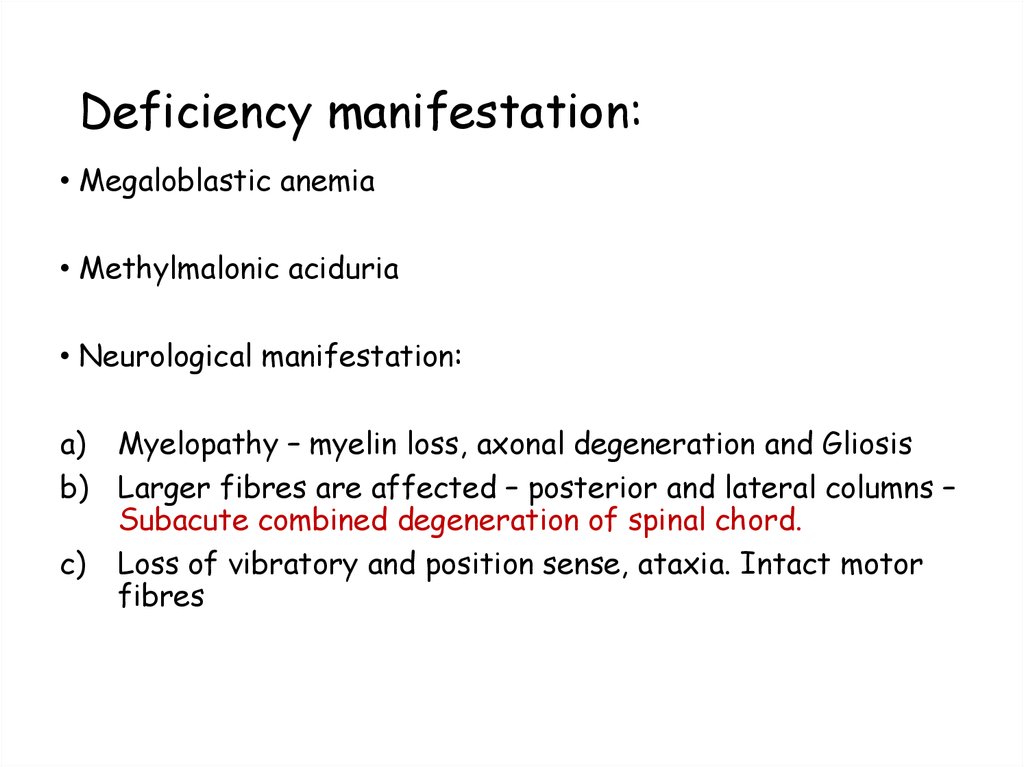












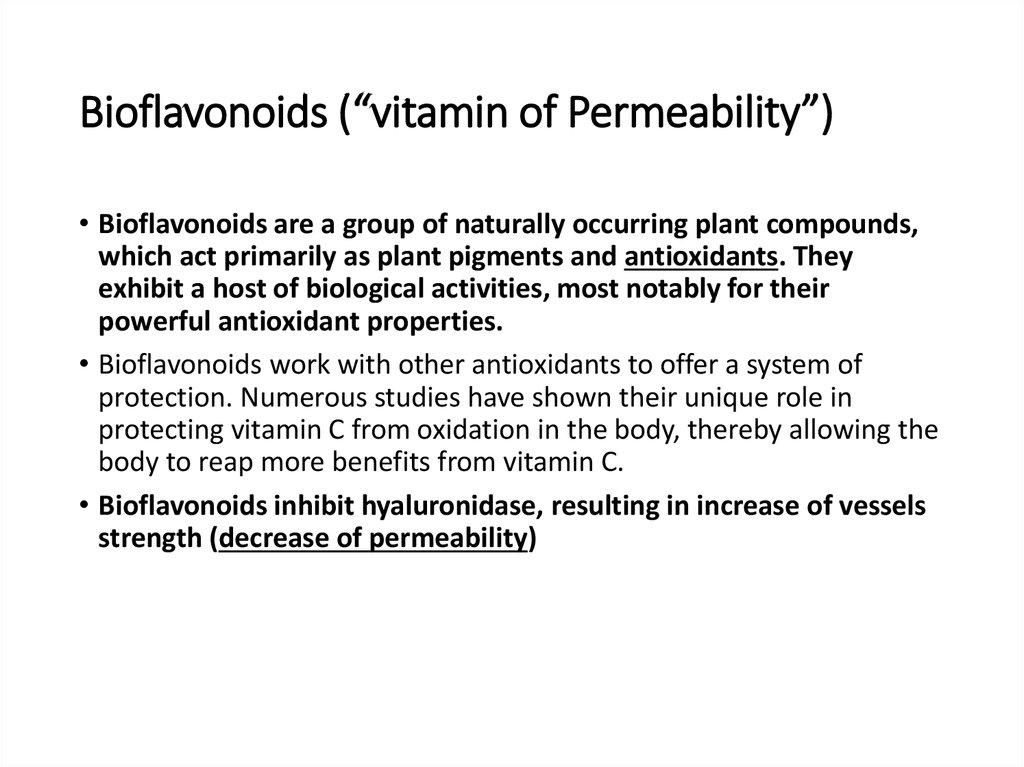

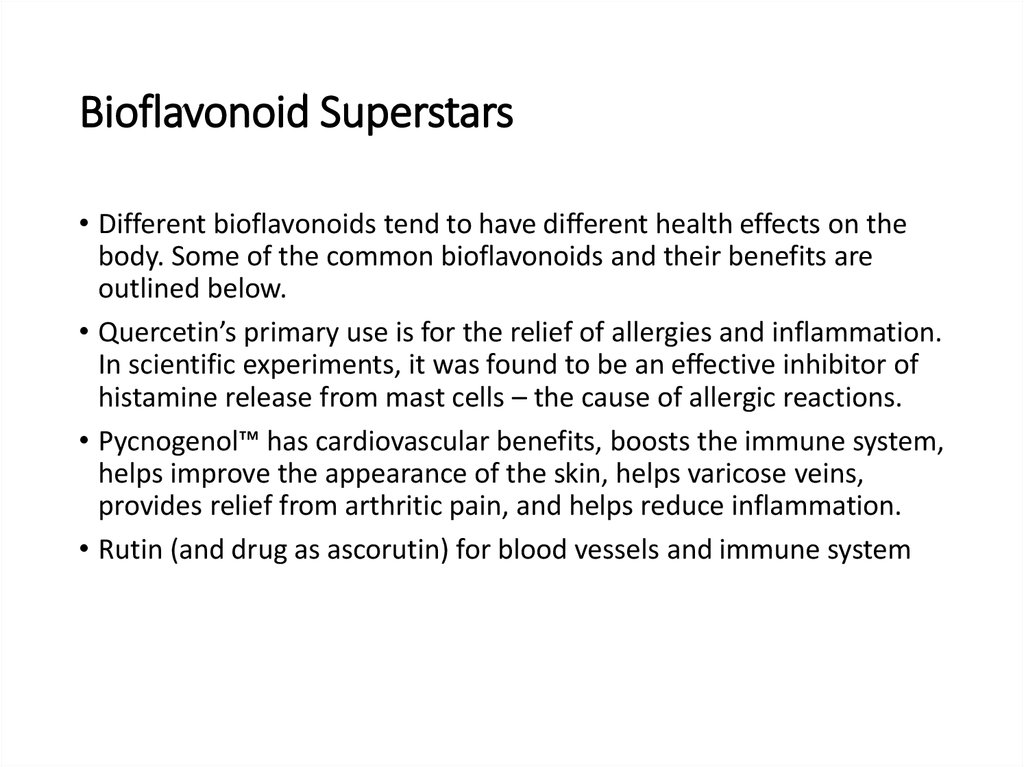








 biology
biology








